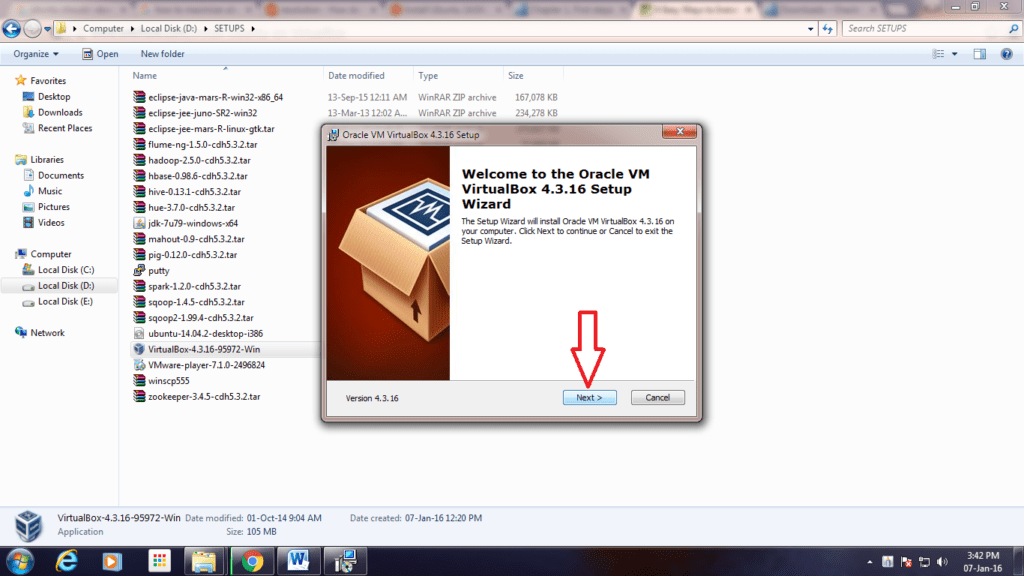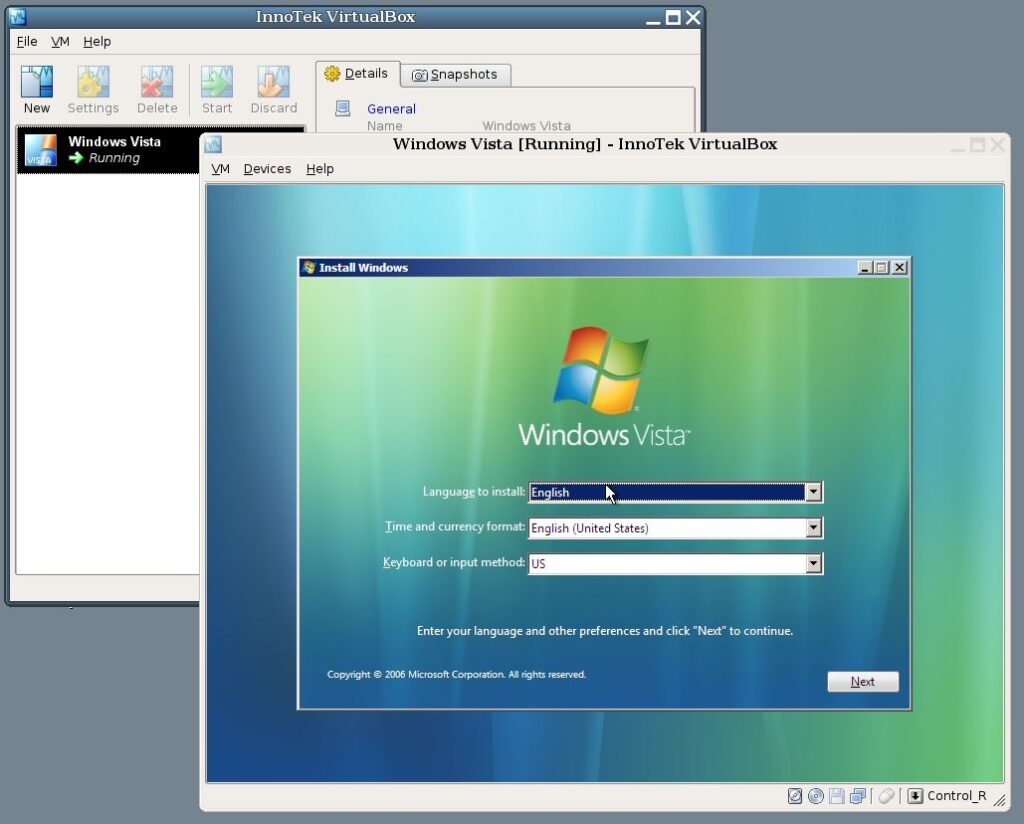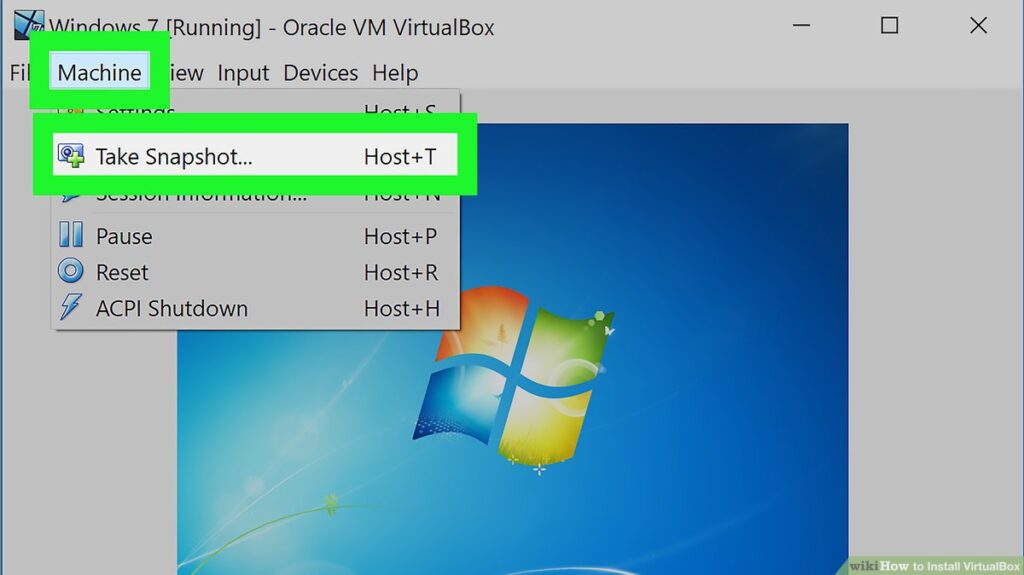Content Attributes
In this article we will see how to install VirtualBox on Windows operating system, including Windows 7, Windows 8.X and Windows 10. VirtualBox, originally developed by Sun MicroSystems and now owned by Oracle, can simulate a standalone PC.
Each virtual machine can run its own operating system and is self-contained. Which means you can erase the machine and your host system will revert to its original state. Virtual machines can interact with each other and be part of your home network and will be treated as a separate system.

Due to these features and more, VirtualBox allows you to test various operating systems without making permanent changes to your host operating system.
What is VirtualBox?
VirtualBox is open source software for virtualizing x86 computing architecture. It acts as a hypervisor, creating a VM (virtual machine) where the user can run another operating system.
The operating system that VirtualBox runs on called the ” host ” operating system. The operating system running on the VM is called the ” guest ” OS. VirtualBox supports Windows, Linux or MacOS as its guest operating system.
When configuring a virtual machine, the user can specify how many CPU cores. And how much RAM and disk space should be dedicated to the VM. When the VM is running, it can be “paused”. The system execution freezes at that moment and the user can use it again later.
VirtualBox has allowed open source enthusiasts, IT administrators, and tech writers to host multiple operating systems on one host machine for years.
Anyone who wants to test new platforms, develop or manage virtual machine (VM) servers can turn to this free open source tool to strengthen their skills or expand their business services.
This guide is a quick way to get up to speed on VirtualBox. We will update this resource periodically when news and updates about VirtualBox released.
VirtualBox is a graphical user interface and command line tool. That enables you to deploy servers, desktops, and embedded operating systems as virtual machines. A single VirtualBox host can deploy as many guest VMs as the host hardware can handle.
VirtualBox consists of hosts and guests. The host hosts the VirtualBox software which can then be deployed by the guests. A guest is any supported operating system that runs as a VM.
A VirtualBox host can run on Linux, Windows or MacOS, while a VirtualBox guest can consist of any Linux, Solaris, MacOS, BSD, IBM OS / 2 or Windows distribution. In order to run macOS or Windows as a VM. You must have a licensed copy of the operating system in question.
The host can run as many guests as the supporting hardware, leaving enough resources for the host to function. Each individual guest can be started, stopped and paused either from the GUI or the command line and can function on a network as if it were running on its own hardware.
VirtualBox can be launched from an easy-to-use GUI or from the command line. Thanks to the command line option, virtual machines can be deployed on a server with or without a GUI, making the software highly flexible.
When using VirtualBox as a hosting platform, administrators can deploy hosts from ISO images or from VDI / VMDK / VHD images.
If guests are deployed from an ISO image, the guest operating system is installed normally, just as a VM. With VDI / VMDK / VHD images, you can quickly deploy a virtual appliance without going through the steps of installing the operating system as a guest. A great place to find virtual appliances for VirtualBox is TurnKey Linux.
To make VirtualBox even more attractive, the VirtualBox Extension Pack is available, which adds support for USB 2.0 and USB 3.0 devices, VirtualBox RDP, disk encryption, NVMe and PXE boot for Intel cards.
There’s also the Guest Additions, which extends VirtualBox’s feature set to include mouse pointer integration, shared folders (between guest and host), improved video support, seamless windows, generic communication channels between host. and guest, time sync, shared clipboard, and automated logins.
Why is VirtualBox important?
VMs give administrators an easy route to testing and developing platforms. VirtualBox makes this not only easy, but also affordable.
Since VirtualBox is free, anyone can use this software to expand the capabilities and offerings for their business. With businesses growing more and more dependent on Linux, it will be crucial for administrators to be able to work with the platform.
VirtualBox makes Linux guest deployment easy without having to use expensive hardware. With VirtualBox administrators can even emulate a network to improve their skills or test implementations.
VirtualBox makes it possible for anyone from end users to company IT staff to work with virtualization. The GUI tool requires very little in the way of a learning curve, so you won’t get in the way of learning about the guest platform.
Considering that container technology has been brought to the forefront of IT, VirtualBox makes it incredibly easy for administrators to test tools like Docker, especially thanks to distributions, including boot2docker.
Since when is VirtualBox available?
The first iteration of VirtualBox was released on January 15, 2007, by Innotek GmbH, a software company located in Stuttgart, Germany, under a proprietary software license.
Innotek made a version of VirtualBox available at no cost for your personal evaluation. In 2007, under the leadership of LiSoG (Die Linux Solution Group), Innotek published an open source edition of VirtualBox (licensed under the GPL version 2).
Past In February 2008, Sun Microsystems acquired Innotek. In January 2010, Oracle Corporation acquired Sun and changed the name of VirtualBox to Oracle VM VirtualBox.
Currently, VirtualBox is in its 6th iteration, and product development is ongoing.
Requirements to use VirtualBox
Anyone can download and install VirtualBox. Linux users will find VirtualBox in the default repositories of their distributions. So the software installed through the package manager of the operating system.
For Windows and MacOS users, they must use the official installation files: Windows or macOS. Once installed, VirtualBox is ready to deploy VMs from your downloaded Linux ISO images, from your licensed Windows or macOS installation discs, or from any number of virtual appliances.
Viable host candidates include the following.
Windows:
- Windows Vista SP1 and later (32-bit and 64-bit)
- Windows Server 2008 (64-bit)
- Windows Server 2008 R2 (64-bit)
- Windows 7 (32-bit and 64-bit)
- Windows 8 (32-bit and 64-bit)
- Windows 8.1 (32-bit and 64-bit)
- Windows 10 RTM build 10240 (32-bit and 64-bit)
- Windows Server 2012 (64-bit)
- Windows Server 2012 R2 (64-bit)
Apple OS X:
- (Mavericks)
- (Yosemite)
- (El Capitan)
Linux:
- Ubuntu 10.04 to 16.04
- Debian GNU / Linux 6.0 (“Squeeze”) and 8.0 (“Jessie”)
- Oracle Enterprise Linux 5, Oracle Linux 6 and 7
- RedHat Enterprise Linux 5, 6, and 7
- Gentoo Linux
- Fedora Core / Fedora 6 to 24
- openSUSE 11.4 to 13.2
It is important to note that the host machine will need to have enough additional resources (storage and RAM) to run the guest virtual machines, as well as the host. The minimum system requirements are:
Reasonably powerful x86 hardware (the amount of RAM will depend on the number of VMs being deployed, but 16GB is a good minimum)
Storage : VirtualBox only requires about 30MB of hard drive space. You will need enough storage to host your virtual machines, and virtual machines can easily start with 10GB each.
How to download VirtualBox?

The first step in downloading the program is to go to its official website. Within the download section you will find links to download the installation package for the different operating systems for which it is available. In this case we interested in the installer for Windows.
- When the download process is complete, all you have to do is double click on the executable .exe file to start the program’s installation wizard. Normally the file saved inside the download folder of your computer.
- After double clicking on the file, the installation wizard will open. The process is very simple, and recommended to click on «Next» until you reach the end. In any case, we offer you a detailed guide to the install virtualbox on window 10.
- VirtualBox allows us to disable the installation of some components if we are not going to use them. To do this we just have to click on the small inverted triangle and then use the corresponding option. Our recommendation is that you click on «Next without touching anything».
- Now is the time to select if we want the installation wizard to create shortcuts to the program on the desktop and the Windows 10 task menu. You must choose these options to your liking, although we recommend that you leave it by default and click on « Next ».
- The next step is to install VirtualBox network interface. It is a necessary driver to be able to access the Internet from the virtual machines that we create, so we need to install it. For this we only need to make a couple of clicks with the mouse.
- At the end of the installation you will be able to check a box so that VirtualBox opens immediately after finishing the process.
How to use VirtualBox to create a virtual machine?
After completing the install VirtualBox process, the program is fully accessible from the Windows 10 Start menu. You can use the search engine included in this menu to find it easily.
This will open the main VirtualBox interface, from which we can manage all our virtual machines. Logically after installing the program you will not have any, so the first step will be to create a virtual machine. To do this, you just need to use the ” New ” button at the top of the interface.
- The wizard for creating a new virtual machine opens. The first step will be to select the type of operating system you want to install, in our case it is Ubuntu.
- The next step is to allocate an amount of RAM to the virtual machine you are creating. This depends on the amount of RAM your PC has, but if it has 8GB or more of RAM, you should be able to allocate 4GB to the virtual machine without a problem. For this reason, we recommend that you allocate 4096 MB of RAM memory.
- Now you will have to create a virtual hard disk drive. Where all the data of the virtual machine you are creating saved.
- You can have the virtual hard disk storage space dynamically reserved needed or fully reserved from scratch. We recommend the ” Dynamically reserved ” option.
- The next step is to allocate an amount of space to the virtual hard disk that you are going to create. If you have chosen the option to dynamically reserve the space, we recommend that you be generous in this option. We are going to choose 15 GB.
- With this, you will have the virtual machine created and ready to use. Now you just need to install the operating system and you can use it as if it were a second independent PC.
How to install an operating system in VirtualBox?

- After creating your first virtual machine in VirtualBox, you will need to install an operating system to start using it. To do this you need to select the virtual machine in the menu on the left side of the screen, and then click on the ” Start ” button at the top of the interface.
- After booting the virtual machine, the system will detect that there is no operating system installed. Therefore, it will ask you to select a medium from which to start the system.
- In this case we will use an Ubuntu ISO image to perform the system installation. To do this you have to click on the small folder-shaped icon that indicated in the following image.
- With this we will access the list of available boot media. In this case you will not have any options available, so the next step will be to add the Ubuntu ISO image. To do so, click on the « Add « button.
- The Windows 10 file explorer will open, you just need to select the ISO image of the operating system to install and click on « Open «.
- With this, it will appear in the list of boot media available to select. Just mark it with the mouse and then click on « Select «.
- VirtualBox will return to the main screen of the virtual machine, make sure that you have selected the operating system you want to install and click on « Start «.
- A few minutes later, the installation wizard for the chosen operating system will appear. From here the process is different depending on the operating system you have selected.
- Here is a gallery of images that show the Ubuntu installation process, one of the best GNU / Linux distributions that we can find.
- These are all the most important steps you need to take to start using VirtualBox. If you have any questions you can leave a comment.